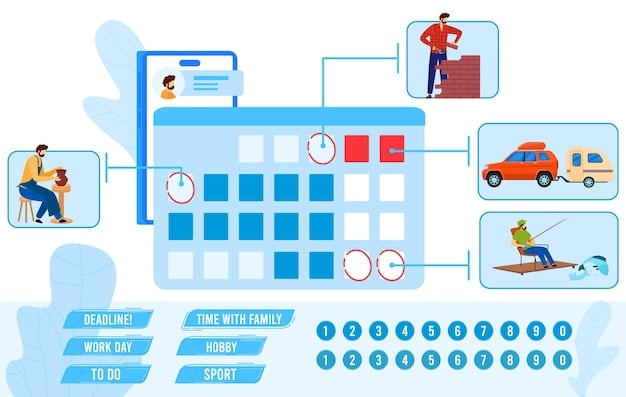The Ultimate Guide to Building a Personal Growth Plan in 90 Days

Discover how to create an effective personal growth plan that delivers tangible results in just 90 days, focusing on goal setting, habit formation, and consistent self-improvement strategies.
Ready to transform your life in just 90 days? This The Ultimate Guide to Building a Personal Growth Plan That Works in 90 Days will help you set achievable goals, develop empowering habits, and unlock your full potential through consistent self-improvement strategies.
Understanding the Foundation of Personal Growth
Personal growth is not just about changing; it’s about evolving into the best version of yourself. It’s a continuous journey of self-discovery and improvement, where you identify your aspirations, set meaningful goals, and take consistent action to achieve them.
But where do you even begin?
Defining Personal Growth
Personal growth encompasses a wide range of areas, including your career, relationships, health, and mindset. It’s about expanding your knowledge, skills, and experiences to enhance your overall well-being and satisfaction in life.
It is a journey unique to each individual, influenced by personal values, experiences, and aspirations.
Why a 90-Day Plan?
A 90-day plan provides a structured timeframe for focused effort and tangible progress. It’s long enough to establish new habits and see meaningful results, yet short enough to maintain motivation and momentum.
- Focused Effort: A defined timeframe helps you concentrate your energy on specific goals, increasing your chances of success.
- Measurable Progress: Regular progress checks within the 90 days keep you motivated and allow for timely adjustments.
- Habit Formation: This duration is ideal for establishing new habits, as consistent action over a period of time reinforces new behaviors.
- Increased Motivation: Short-term goals are less daunting, making the overall journey more manageable and encouraging continuous effort.
Ultimately, personal growth is a process that pays dividends both professionally and personally.
Setting Powerful Goals for Your Transformation
Goal setting is the cornerstone of any successful personal growth plan. Without clear, well-defined goals, you’ll lack direction and motivation, making it difficult to achieve lasting change.
But what makes a goal truly “powerful”?

The SMART Goal Framework
The SMART framework provides a structured approach to goal setting, ensuring your objectives are specific, measurable, achievable, relevant, and time-bound.
Let’s break this down further.
Applying SMART to Personal Growth
Consider a vague goal like “get healthier.” To make it SMART, you could transform it into “lose 10 pounds in 90 days by exercising 3 times a week and following a balanced diet.” This revised goal is specific (lose 10 pounds), measurable (tracking weight), achievable (realistic target), relevant (aligned with overall health), and time-bound (90 days).
Consider these guiding questions:
- Specific:What exactly do you want to achieve?
- Measurable:How will you track your progress?
- Achievable:Is this goal realistic and attainable?
- Relevant:Why is this goal important to you?
- Time-bound:When do you want to achieve this goal?
It can be beneficial to break down the large goal into shorter segments in order to monitor progress.
Identifying Key Areas for Your Growth
Personal growth encompasses a broad spectrum of areas, from your career and finances to your relationships and mental well-being. Identifying the key areas that need improvement is crucial for targeted growth.
These are questions to ask yourself to get started:
Assessing Your Current Situation
Start by honestly evaluating your current situation in various aspects of your life. Identify your strengths, weaknesses, and areas where you desire improvement.
Take an honest inventory of factors at play.
Common Areas for Personal Growth
Many people seek personal growth in areas such as career development, improved communication skills, enhanced relationships, financial stability, and stress management. However, the ideal areas for you depend on your unique circumstances and aspirations.
- Career: Enhancing skills, seeking promotions, starting a business.
- Relationships: Improving communication, building stronger bonds, resolving conflicts.
- Finances: Saving more, investing wisely, reducing debt.
- Health: Exercising regularly, eating healthy, managing stress.
It is important to check in frequently to reassess.
Creating an Actionable Roadmap
An actionable roadmap transforms your goals into a concrete plan of action. It outlines the specific steps you need to take, the resources you’ll require, and the timeline for achieving your objectives.
The roadmap acts as a visual representation the path ahead.
Breaking Down Your Goals into Smaller Steps
Divide each goal into smaller, manageable tasks that you can tackle on a daily or weekly basis. This makes the overall goal less daunting and provides a sense of accomplishment as you complete each step.
For example, it can be helpful to determine what habits can be broken down.
Choosing the Right Resources and Tools
Identify any resources or tools that can support your progress, such as books, online courses, mentors, or apps. Leverage these resources to accelerate your learning and overcome obstacles.
These tools can drastically assist and simplify the process:
- Books: Provide in-depth knowledge and insights on various topics.
- Online Courses: Offer structured learning and skill development.
- Mentors: Provide guidance, support, and accountability.
- Apps: Track progress, manage tasks, and build habits.
The key is to identify what resources are useful in your specific area of growth.

Cultivating Daily Habits That Fuel Your Success
Consistent habits are the building blocks of lasting personal growth. Integrating positive habits into your daily routine can significantly accelerate your progress toward your goals.
Start by choosing one habit aligned to these goals.
Identifying Key Habits for Growth
Assess which habits will have the most significant impact on your chosen areas of growth. These might include daily exercise, regular reading, mindfulness practices, or consistent networking.
Think to yourself:
Building and Maintaining Good Habits
Start small and gradually increase the intensity of your new habits. Use techniques like habit stacking (linking new habits to existing ones) and reward systems to reinforce positive behaviors.
As Atomic Habits explains:
- Start Small: Begin with manageable increments to build momentum.
- Habit Stacking: Link new habits to existing routines for consistency.
- Reward Systems: Reinforce positive behaviors with incentives.
- Consistency: Prioritize daily practice, even in small amounts.
There are many tools to help you remember and implement.
Overcoming Obstacles and Staying Motivated
The path to personal growth is rarely smooth. You’ll inevitably encounter obstacles, setbacks, and moments of doubt. Developing strategies to overcome these challenges is crucial for maintaining motivation and staying on track.
Even with the perfect plan, this is to be expected.
Dealing with Setbacks
View setbacks as learning opportunities rather than failures. Analyze what went wrong, adjust your approach, and keep moving forward. Remember that progress is not always linear.
It’s also important to remember that perfection is unattainable.
Maintaining Motivation
Celebrate small wins, track your progress, and surround yourself with a supportive network. Visualize your success and remind yourself of the reasons why your personal growth goals are important to you.
- Celebrate Wins: Acknowledge and reward your accomplishments, no matter how small.
- Track Progress: Monitor your journey to see how far you’ve come.
- Support Network: Surround yourself with positive and encouraging people.
- Visualize Success: Imagine achieving your goals to stay inspired.
It can be helpful to read stories of others who have encountered similar challenges.
Measuring Your Progress and Adjusting Your Plan
Regularly monitoring your progress is essential for gauging the effectiveness of your personal growth plan. Tracking your achievements, identifying areas where you’re falling short, and making necessary adjustments will keep you on the path to success.
Make sure to track data over a wide period of time.
Tracking Key Metrics
Identify the key metrics that indicate progress in your chosen areas of growth. This might include weight loss, improved communication skills, increased income, or reduced stress levels. Use tools like journals, spreadsheets, or apps to track your numbers.
Knowing specifically what to measure is central.
Making Necessary Adjustments
Based on your progress, be prepared to adjust your plan as needed. This might involve modifying your goals, changing your strategies, or seeking additional support. Adaptability is key to long-term success.
It is important to:
- Regularly Monitor Metrics: Consistently track progress to identify trends.
- Adjust Strategies: Modify your approach based on results and feedback.
- Seek Support: Don’t hesitate to ask for guidance when needed.
- Stay Flexible: Be open to changing your plan as new insights emerge.
The goal is to be flexible as well as persistent.
| Key Point | Brief Description |
|---|---|
| 🎯 Goal Setting | Define SMART goals for clarity; use the SMART framework for effective personal growth. |
| 🌱 Habit Formation | Cultivate positive habits vital for sustained success and consistent progress. |
| 💪 Motivation | Stay motivated by celebrating small wins and dealing with setbacks constructively. |
| 📊 Progress Tracking | Monitor progress regularly and adjust strategies for effective personal development. |
Frequently Asked Questions
▼
The first step is to define clear, specific goals aligned with your values and aspirations. Understanding what you want to achieve provides direction and motivation for your journey.
▼
Stay motivated by celebrating small wins, tracking your progress, and surrounding yourself with a supportive network. Visualize your success and remind yourself of why your goals are important.
▼
View setbacks as learning opportunities, not failures. Analyze what went wrong, adjust your approach, and keep moving forward. Remember that progress is not always linear and persistence is key.
▼
It’s beneficial to review your plan weekly and make adjustments as needed. This allows you to stay on track and adapt to any changes or obstacles that arise, ensuring continuous progress.
▼
Avoid setting unrealistic goals, not tracking your progress, neglecting self-care, and failing to seek support when needed. These common pitfalls can derail your efforts and hinder your personal growth.
Conclusion
Building a personal growth plan that works in 90 days requires clarity, commitment, and consistent effort. By setting SMART goals, cultivating positive habits, and staying adaptable, you can unlock your full potential and transform your life.





